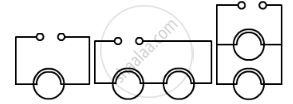Advertisements
Advertisements
प्रश्न
Three resistors are connected as shown in the diagram.
Through the resistor 5 ohm, a current of 1 ampere is flowing.
(i) What is the current through the other two resistors?
(ii) What is the p.d. across AB and across AC?
(iii) What is the total resistance
उत्तर
The resistance between B and C are in parallel. Hence the total resistance, R between B and C is given by:
RBC= [15 x 10 ] / [ 15 + 10 ] = 6 Ω ... (a)
Potential drop across B and C = IR = 1 x 6 = 6 V
Current through the 10 Ω resistor = V / R = 6 / 10 = 0.6 A
Current through the 15 Ω resistor = V / R = 6 / 15 = 0.4 A
p.d. across AB:
VAB = 5 x 1 = 5 V
p.d. across AC:
VAC = I x RAC
RAC = R + 5 = 11 Ω (see equation (a) )
VAC = 1 x 11 = 11 V
Total resistance, RAC = RBC + RAC
= 6 + 5
= 11 Î
APPEARS IN
संबंधित प्रश्न
Choose the correct alternative and rewrite the following sentence.
When the resistance of a conductor increases, the current will ________ increase.
One coulomb charge is equivalent to the charge contained in:
(a) 2.6 × 1019 electrons
(b) 6.2 × 1019 electrons
(c) 2.65 × 1018 electrons
(d) 6.25 × 1018 electrons
In which direction does conventional current flow around a circuit?
Consider the circuit given below:

(a) In which circuit are the lamps dimmest?
(b) In which circuit or circuits are the lamps of equal brightness to the lamps in circuit (i)?
(c) Which circuit gives out the maximum light?
Calculate the current through a 60 W lamp rated 250 V. If the line voltage falls to 200 V, how is power consumed by the bulb affected?
Kilowatt hour is the unit of
